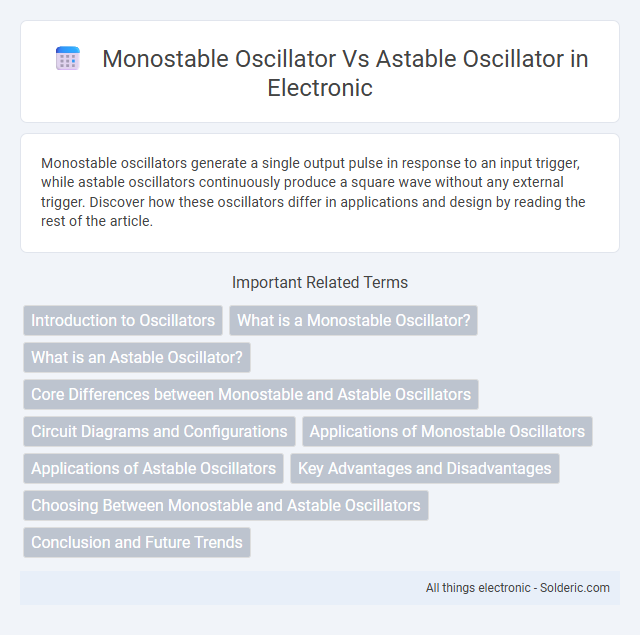Monostable oscillators generate a single output pulse in response to an input trigger, while astable oscillators continuously produce a square wave without any external trigger. Discover how these oscillators differ in applications and design by reading the rest of the article.
Comparison Table
| Feature | Monostable Oscillator | Astable Oscillator |
|---|---|---|
| Operation Mode | One stable state, generates a single output pulse | No stable state, continuous output oscillation |
| Output Waveform | Single pulse (monopulse) | Square wave |
| Trigger | Requires external trigger to start | Self-triggering, runs continuously |
| Applications | Timer, pulse generation, debounce circuits | Clock pulses, LED flashers, tone generation |
| Frequency | Determined by external input pulse and timing components | Determined by RC network or timing components |
| Stability | One stable state, returns after pulse | No stable state, oscillates continuously |
Introduction to Oscillators
Monostable oscillators generate a single output pulse of fixed duration in response to an input trigger, making them ideal for timing and pulse generation applications. Astable oscillators continuously switch between high and low states without external triggers, producing a square wave output suitable for clock signals and waveform generation. Both types are fundamental in electronic circuits for controlling timing and oscillation functions.
What is a Monostable Oscillator?
A monostable oscillator, also known as a one-shot pulse generator, produces a single output pulse of a fixed duration in response to an external trigger, making it ideal for timing applications and pulse-width modulation. Unlike an astable oscillator that continuously oscillates between high and low states, a monostable oscillator remains in its stable state until triggered, ensuring precise control over pulse output. Your electronic circuits benefit from monostable oscillators by enabling accurate timing intervals and preventing unintended continuous signals.
What is an Astable Oscillator?
An astable oscillator is an electronic circuit that continuously switches between two states without any external triggering, producing a square wave output. It has no stable states, meaning it never rests in a fixed voltage level, making it ideal for generating clock pulses or timing signals. Common implementations include the 555 timer IC in astable mode, which is widely used in digital circuits for pulse generation.
Core Differences between Monostable and Astable Oscillators
Monostable oscillators produce a single output pulse of fixed duration in response to an input trigger, functioning as one-shot pulse generators with a stable output state. Astable oscillators continuously switch between two states, generating a square wave without any external trigger, operating as free-running multivibrators. The key difference lies in monostable oscillators having one stable state and requiring a trigger to produce an output pulse, whereas astable oscillators have no stable state and oscillate indefinitely.
Circuit Diagrams and Configurations
Monostable oscillator circuit diagrams typically consist of a single stable state with one timing component, such as a resistor and capacitor, determining the pulse width, often configured around a 555 timer IC in monostable mode. Astable oscillator circuits feature no stable state, continuously oscillating between high and low outputs with two timing components that set the frequency, commonly realized using a 555 timer in astable mode with resistors and a capacitor in a specific feedback loop. The configurations differ fundamentally: monostable circuits have a trigger input to initiate output pulses, while astable circuits generate continuous waveforms without external triggers.
Applications of Monostable Oscillators
Monostable oscillators are widely used in timing applications such as pulse generation, delay circuits, and time interval measurement. Your electronic devices benefit from monostable oscillators when precise single pulse output is essential for triggering events like timers, flip-flops, and missing pulse detectors. These oscillators provide stable and reliable timing signals critical in communication systems, digital circuits, and sensor interfacing.
Applications of Astable Oscillators
Astable oscillators produce continuous square wave signals, making them ideal for applications like clock pulse generation in digital circuits, LED and lamp flashers, and tone generation in audio devices. They are widely used in timer circuits, pulse width modulation (PWM) controllers, and as waveform generators in communication systems. Your electronic projects benefit from astable oscillators when a stable and continuous oscillating output is required without external triggering.
Key Advantages and Disadvantages
Monostable oscillators offer precise single-pulse generation with high timing accuracy, making them ideal for applications like timers and pulse-width modulation, but require external triggers and have limited duty cycle control. Astable oscillators provide continuous square wave output without external input, useful for clock generation and blinking LEDs, though they may suffer from frequency and amplitude instability due to component tolerances. Monostables excel in controlled pulse timing, while astables prioritize simplicity and continuous signal generation, each with trade-offs in complexity and signal stability.
Choosing Between Monostable and Astable Oscillators
Choosing between monostable and astable oscillators depends on the desired output signal and application requirements. Monostable oscillators produce a single pulse output in response to an input trigger, ideal for timing delays and pulse generation, while astable oscillators generate continuous square waves suitable for clock signals and waveform generation. Consider pulse duration accuracy, frequency stability, and circuit complexity when selecting the appropriate oscillator for precise timing or continuous oscillation tasks.
Conclusion and Future Trends
Monostable oscillators generate a single pulse per trigger, making them ideal for precise timing applications, while astable oscillators produce continuous oscillations suited for clock generation and signal modulation. Future trends include integrating CMOS technology to enhance oscillator stability and power efficiency, with potential expansion into IoT devices and adaptive timing circuits. Your choice between these oscillators depends on application requirements, and advancements will likely offer more versatile and low-power solutions.
monostable oscillator vs astable oscillator Infographic

 solderic.com
solderic.com